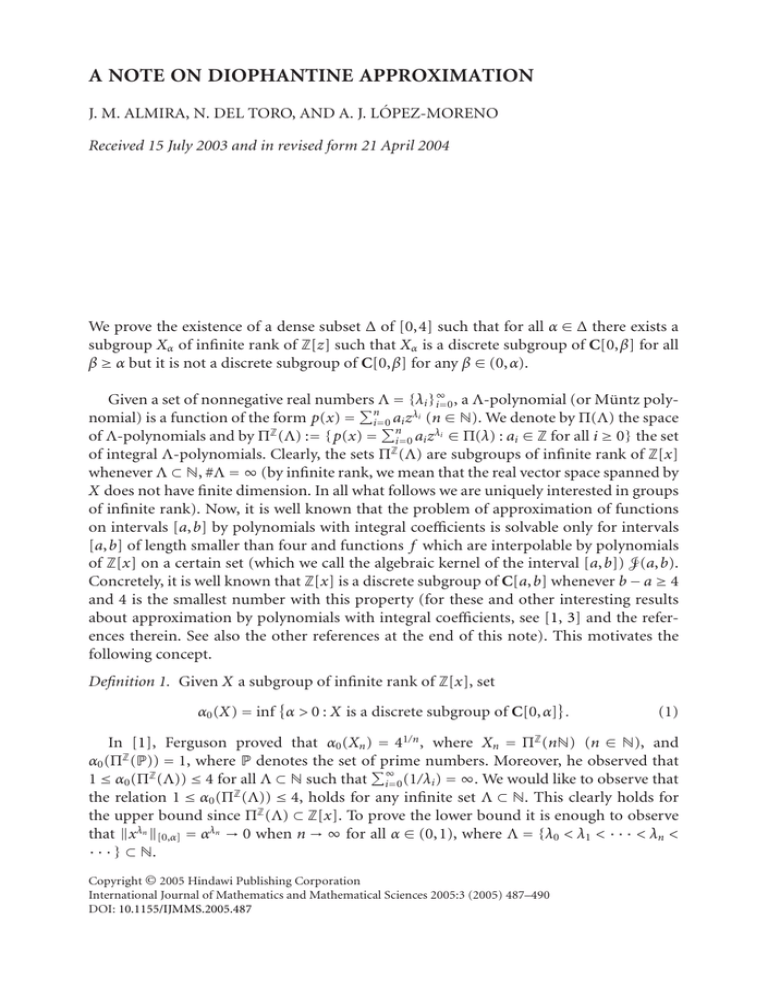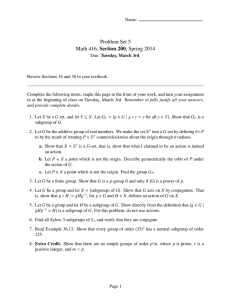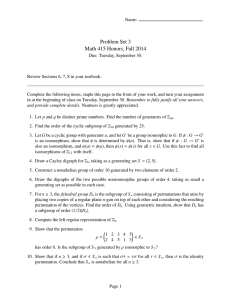A NOTE ON DIOPHANTINE APPROXIMATION
advertisement

A NOTE ON DIOPHANTINE APPROXIMATION
J. M. ALMIRA, N. DEL TORO, AND A. J. LÓPEZ-MORENO
Received 15 July 2003 and in revised form 21 April 2004
We prove the existence of a dense subset ∆ of [0,4] such that for all α ∈ ∆ there exists a
subgroup Xα of infinite rank of Z[z] such that Xα is a discrete subgroup of C[0,β] for all
β ≥ α but it is not a discrete subgroup of C[0,β] for any β ∈ (0,α).
Given a set of nonnegative real numbers
Λ = {λi }∞
i=0 , a Λ-polynomial (or Müntz polyn
λi
nomial) is a function of the form p(x) = i=
0 ai z (n ∈ N). We denote by Π(Λ) the space
of Λ-polynomials and by ΠZ (Λ) := { p(x) = ni=0 ai zλi ∈ Π(λ) : ai ∈ Z for all i ≥ 0} the set
of integral Λ-polynomials. Clearly, the sets ΠZ (Λ) are subgroups of infinite rank of Z[x]
whenever Λ ⊂ N, #Λ = ∞ (by infinite rank, we mean that the real vector space spanned by
X does not have finite dimension. In all what follows we are uniquely interested in groups
of infinite rank). Now, it is well known that the problem of approximation of functions
on intervals [a,b] by polynomials with integral coefficients is solvable only for intervals
[a,b] of length smaller than four and functions f which are interpolable by polynomials
of Z[x] on a certain set (which we call the algebraic kernel of the interval [a,b]) (a,b).
Concretely, it is well known that Z[x] is a discrete subgroup of C[a,b] whenever b − a ≥ 4
and 4 is the smallest number with this property (for these and other interesting results
about approximation by polynomials with integral coefficients, see [1, 3] and the references therein. See also the other references at the end of this note). This motivates the
following concept.
Definition 1. Given X a subgroup of infinite rank of Z[x], set
α0 (X) = inf α > 0 : X is a discrete subgroup of C[0,α] .
(1)
In [1], Ferguson proved that α0 (Xn ) = 41/n , where Xn = ΠZ (nN) (n ∈ N), and
α0 (ΠZ (P)) = 1, where P denotes the set ofprime numbers. Moreover, he observed that
1 ≤ α0 (ΠZ (Λ)) ≤ 4 for all Λ ⊂ N such that ∞
i=0 (1/λi ) = ∞. We would like to observe that
the relation 1 ≤ α0 (ΠZ (Λ)) ≤ 4, holds for any infinite set Λ ⊂ N. This clearly holds for
the upper bound since ΠZ (Λ) ⊂ Z[x]. To prove the lower bound it is enough to observe
that xλn [0,α] = αλn → 0 when n → ∞ for all α ∈ (0,1), where Λ = {λ0 < λ1 < · · · < λn <
· · · } ⊂ N.
Copyright © 2005 Hindawi Publishing Corporation
International Journal of Mathematics and Mathematical Sciences 2005:3 (2005) 487–490
DOI: 10.1155/IJMMS.2005.487
488
Note on Diophantine approximation
In general, the numbers α0 (X) are not easy to compute. Moreover, they do not have
nice properties in connection with the elementary operations of sets. For example, the
knowledge of α0 (Xi ) (i = 1,2) does not help for computing the numbers α0 (X1 + X2 ) and
α0 (X1 ∩ X2 ).
Anyway, we have the following elementary properties.
Proposition 2. Assume that X is a discrete subgroup of C[0,α]. Then X is also a discrete
subgroup of C[0,β] for all β > α.
Proof. By definition, X is a discrete subgroup of C[0,α] if and only if there exists a positive
number ε > 0 such that
p[0,α] ≥ ε
∀ p ∈ X \ {0 }.
(2)
Hence, β ≥ α implies that X is a discrete subgroup of C[0,β], since
p[0,β] ≥ p[0,α] ≥ ε
∀ p ∈ X \ {0 }.
(3)
Corollary 3. Assume that X1 ⊂ X2 are two subgroups of Z[x] of infinite rank. Then
α0 (X1 ) ≤ α0 (X2 ).
Proof. We assume that α0 (X2 ) < α0 (X1 ) and take α ∈ (α0 (X2 ),α0 (X1 )). Then X2 is a discrete subgroup of C[0,α] (since α > α0 (X2 )), so that
p[0,α] ≥ ε
∀ p ∈ X2 \ {0}.
(4)
p[0,α] ≥ ε
∀ p ∈ X1 \ {0},
(5)
Hence
since X1 ⊂ X2 . This implies that α ≥ α0 (X1 ), a contradiction.
Corollary 4. With the same notation as in the corollary above, it holds that α0 (X1 + X2 ) ≥
max{α0 (X1 ),α0 (X2 )} and α0 (X1 ∩ X2 ) ≤ min{α0 (X1 ),α0 (X2 )}. Moreover, there are examples where the inequalities are strict.
Proof. We only prove that the inequalities are strict, in general (since the other claim is a
trivial consequence of the proposition above). To do this, we give the following examples:
We set X1 = ΠZ (2N), X2 = ΠZ (N \ 2N) and Y1 = ΠZ (2N), Y2 = ΠZ (3N). Then
Z[x] = ΠZ (2N) + ΠZ (N \ 2N),
4 = α0 Z[x] > 2 = α0 ΠZ (2N) = α0 ΠZ (N \ 2N) .
(6)
(7)
Finally, Y1 ∩ Y2 = ΠZ (6N), so that
α0 Y1 ∩ Y2 = α0 ΠZ (6N) = 41/6 < 41/3 = min α0 Y1 ,α0 Y2 .
Now we prove the main result of this note.
(8)
J. M. Almira et al. 489
Theorem 5. Set
∆ = α0 (X) : X is a subgroup of infinite rank of Z[x] .
(9)
R
Then ∆ = [0,4].
Proof. Let α ∈ (0,4) be a transcendent number and we denote by Jα = J(0,α) the algebraic
kernel of the interval [0, α]. We know that Jα is a finite subset of [0,α] and α ∈ Jα . Thus
ρ(α) = max Jα < α. For each ε ∈ (0,(α − ρ(α))/2), we take a function ϕα,ε such that ϕα,ε ∈
C1 [0,α], ϕα,ε (x) = x for all x ∈ [0,ρ(α)], ϕα,ε (0) = 0, ϕα,ε (α − ε) = 4 − ε, ϕα,ε (α) = 4 + ε,
(k)
and ϕα,ε (x) > 0 for all x ∈ [0,α]. This function satisfies (ϕ(k)
α,ε )|Jα = p|Jα , k = 0,1, for p(x) =
1
x. Thus, ϕα,ε belongs to the closure of Z[x] in C [0,α] (see [2, Theorem 12.1]), so that
there exists a polynomial qα,ε ∈ Z[x] such that
ϕα,ε − qα,ε C1 [0,α]
ε
< .
2
(10)
This implies that qα,ε is an strictly increasing function on [0, α], qα,ε (0) = 0 and there
exists a certain number ηα,ε ∈ (α − ε,α) such that qα,ε (ηα,ε ) = 4. Hence, qα,ε : [0,ηα,ε ] →
[0,4] is an homeomorphism. We denote by Z[qα,ε ] the ring of polynomials with integral
coefficients in the variable qα,ε (x). Then Z[qα,ε ] is a subgroup of Z[x] of infinite rank. We
claim that
α0 Z qα,ε
= ηα,ε .
(11)
β
β
−1
(β)] given by Φα,ε (u) =
This is clear since, for all β ∈ (0,4] the map Φα,ε : C[0,β] → C[0, qα,ε
u(qα,ε ) is an isometry of normed vector spaces which maps Z[x] onto Z[qα,ε ] and the fact
that α0 (Z[x]) = 4.
If X is a subring of Z[x], then X is a discrete subset of C[0,α] if and only if p[0,α] ≥ 1
for all p ∈ X \ {0} (since p[0,α] < 1 implies that limn→∞ pn [0,α] = 0). This means that,
for all ring X ⊂ Z[x] we have that {α ≥ 0 : X is a discrete subset of C[0,α]} is a closed set,
so that
α0 (X) = min α > 0 : X is a discrete subgroup of C[0,α] .
(12)
In particular, X is a discrete subset of C[0,α0 (X)]. Now, we note that the sets Z[qα,ε ] we
used for the proof of the theorem above were subrings of Z[x], so that we have proved
the existence of a dense subset ∆ of [0,4] such that for all α ∈ ∆ there exists a subgroup
Xα of infinite rank of Z[z] such that Xα is a discrete subgroup of C[0,β] for all β ≥ α but
it is not a discrete subgroup of C[0,β] for any β ∈ (0,α).
We end this note with two open problems:
(P1) is ∆ = [0,4]?
= {α0 (ΠZ (Λ)) : Λ ⊂ N,#Λ = ∞} a dense subset of [0,4]? In particular, is 4 an
(P2) is ∆
accumulation point of ∆?
490
Note on Diophantine approximation
Acknowledgment
Research was partially supported by Junta de Andalucı́a, Grupo de Investigación “Aproximación y Métodos Numéricos” FQM-0178.
References
[1]
[2]
[3]
L. B. O. Ferguson, Approximation by integral Müntz polynomials, Fourier Analysis and Approximation Theory, Vol. I (Proc. Colloq., Budapest, 1976) (G. Alexits and P. Turán, eds.), Colloq.
Math. Soc. János Bolyai, vol. 19, North-Holland, Amsterdam, 1978, pp. 359–370.
, Approximation by Polynomials with Integral Coefficients, Mathematical Surveys,
vol. 17, American Mathematical Society, Rhode Island, 1980.
E. Hewitt and H. S. Zuckerman, Approximation by polynomials with integral coefficients, a reformulation of the Stone-Weierstrass theorem, Duke Math. J. 26 (1959), 305–324.
J. M. Almira: Departamento de Matemáticas, Universidad de Jaén, 23700 Linares (Jaén), Spain
E-mail address: jmalmira@ujaen.es
N. Del Toro: Departamento de Matemáticas, Universidad de Jaén, 23700 Linares (Jaén), Spain
E-mail address: ndeltoro@ujaen.es
A. J. López-Moreno: Departamento de Matemáticas, Universidad de Jaén, 23700 Linares (Jaén),
Spain
E-mail address: ajlopez@ujaen.es





